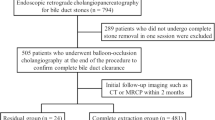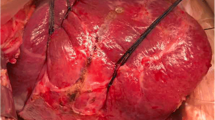Abstract
Purpose
This study aimed to examine the correlation between right posteroinferior bile duct (RPBD) angulation and the occurrence of bile duct stones in patients with hepatolithiasis.
Methods
Patients presenting with hepatolithiasis in our hospital from January 2011 to July 2016 were divided into two groups according to whether their RPBD was affected by stones. A statistical analysis for the relevant factors associated with bile duct stone formation in the RPBD was performed.
Results
The binary logistic regression results showed that stenosis of the right hepatic duct [odds ratio (OR): 7.313; 95% confidence interval (CI) 4.131–12.945)] and the angle of the RPBD (OR 0.896; 95%CI 0.877–0.916) were risk factors associated with the formation of RPBD stones. Further, the receiver operating characteristic curve indicated that, when the angle of the RPBD was less than 44.58°, stones were able to form more easily in the RPBD.
Conclusion
The occurrence of bile duct stones is well correlated with sharp bile duct angulation.



Similar content being viewed by others
References
Tsui WM, Lam PW, Lee WK, Chan YK. Primary hepatolithiasis, recurrent pyogenic cholangitis, and oriental cholangiohepatitis-a tale of 3 countries. Advances in anatomic pathology. 2011; 18(4): 318-328.
Li G, Fang CH, Fan YF, Wu TC, Zhong SZ. A comparative study of the diagnostic accuracy of the medical image three-dimensional visualization system, MRCP, CT and US in hepatolithiasis. Hepato-gastroenterology. 2014; 61(135): 1901-1907.
Chijiiwa K, Ichimiya H, Kuroki S, Koga A, Nakayama F. Late development of cholangiocarcinoma after the treatment of hepatolithiasis. Surgery, gynecology & obstetrics. 1993; 177(3): 279-282.
Ruopp MD, Perkins NJ, Whitcomb BW, Schisterman EF. Youden Index and optimal cut-point estimated from observations affected by a lower limit of detection. Biom J. 2008; 50:419–430.
Jeng KS, Ohta I, Yang FS, Liu TP, Shih SC, Chang WS, et al. Coexisting sharp ductal angulation with intrahepatic biliary strictures in right hepatolithiasis. Archives of Surgery. 1994; 129(10): 1097-1102.
Uchiyama K, Kawai M, Tani M, Terasawa H, Tanimura H, Yamaue H. Pathogenesis of hepatolithiasis based on the analysis of components of intrahepatic stones. Hepato-gastroenterology. 2007; 54(78): 1798-1804.
Mercadier M, Fingerhut A. Strictures of the intrahepatic bile ducts. World journal of surgery. 1984; 8(1): 15-21.
Nakayama T, Ikeda A, Okuda K. Percutaneous transhepatic drainage of the biliary tract: technique and results in 104 cases. Gastroenterology, 1978; 74(3): 554-559.
Li CP, Hwang SJ, Lee FY, Chang FY, Lin HC, Lu RH, et al. Evaluation of gallbladder motility in patients with liver cirrhosis. Digestive diseases and sciences. 2000; 45(6): 1109-1114.
Jeng KS, Shih SC, Chiang HJ, Chen BF. Secondary biliary cirrhosis: a limiting factor in the treatment of hepatolithiasis. Archives of Surgery. 1989; 124(11): 1301-1305.
Kim M H, Lee S S. Current status of intrahepatic stones in Korea. The Korean journal of gastroenterology. 2003; 42(2): 89-95.
Hwang JH, Yoon YB, Kim YT, Cheon JH, Jeong JB. Risk factors for recurrent cholangitis after initial hepatolithiasis treatment. Journal of clinical gastroenterology. 2004; 38(4): 364-367.
Jeng KS, Yang FS, Chiang HJ, Ohta I. Bile duct stents in the management of hepatolithiasis with long‐segment intrahepatic biliary strictures. British journal of surgery. 1992; 79(7): 663-666.
Shoda J, Tanaka N, Osuga T. Hepatolithiasis - epidemiology and pathogenesis update. Frontiers in bioscience: a journal and virtual library. 2003; 8: e398-409.
Tazuma S. Epidemiology, pathogenesis, and classification of biliary stones (common bile duct and intrahepatic). Best practice & research Clinical gastroenterology. 2006; 20(6): 1075-1083.
Funding
This study was supported by Foundation of Southwest Hospital (SWH2016JSTSYB-19).
Author information
Authors and Affiliations
Corresponding authors
Ethics declarations
Conflict of interest
Guangyu Chen and other co-authors have no conflicts of interest.
Additional information
Publisher's Note
Springer Nature remains neutral with regard to jurisdictional claims in published maps and institutional affiliations.
Rights and permissions
About this article
Cite this article
Chen, G., Wu, J., Xiao, L. et al. Right posteroinferior bile duct angulation correlates with bile duct stone occurrence in patients with hepatolithiasis. Abdom Radiol 45, 3103–3108 (2020). https://doi.org/10.1007/s00261-020-02444-3
Published:
Issue Date:
DOI: https://doi.org/10.1007/s00261-020-02444-3




